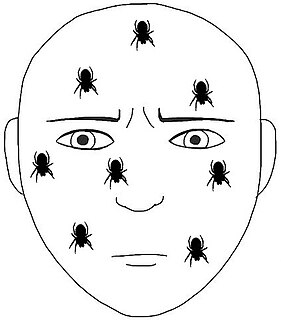Graphesthesia is the ability to recognize writing on the skin purely by the sensation of touch. Its name derives from Greek graphē ("writing") and aisthēsis ("perception"). Graphesthesia tests combined cortical sensation; therefore, it is necessary that primary sensation be intact. [1]

Greek is an independent branch of the Indo-European family of languages, native to Greece, Cyprus and other parts of the Eastern Mediterranean and the Black Sea. It has the longest documented history of any living Indo-European language, spanning more than 3000 years of written records. Its writing system has been the Greek alphabet for the major part of its history; other systems, such as Linear B and the Cypriot syllabary, were used previously. The alphabet arose from the Phoenician script and was in turn the basis of the Latin, Cyrillic, Armenian, Coptic, Gothic, and many other writing systems.
During medical or neurological examination graphesthesia is tested in order to test for certain neurological conditions such as; lesions in brainstem, spinal cord, sensory cortex or thalamus. An examiner writes single numbers or simple letters on the skin (usually the palm) with something that will provide a clear stimulus, such as a broken tongue depressor, pen cap etc. Prior to the start of testing, an agreement may be reached between the examiner and the patient as to the orientation of the letters, although this is often unnecessary, since orientation and size of the figures are rarely an issue. The crucial aspect of testing graphesthesia, as with any sensory testing, is to establish that the patient understands the test, hence the test is commenced, in the hemiplegic patient, on the normal, intact hand. This also allows the examiner to establish the patient's numeracy, since semi-numerate patients may have difficulties performing the task.

A neurological examination is the assessment of sensory neuron and motor responses, especially reflexes, to determine whether the nervous system is impaired. This typically includes a physical examination and a review of the patient's medical history, but not deeper investigation such as neuroimaging. It can be used both as a screening tool and as an investigative tool, the former of which when examining the patient when there is no expected neurological deficit and the latter of which when examining a patient where you do expect to find abnormalities. If a problem is found either in an investigative or screening process, then further tests can be carried out to focus on a particular aspect of the nervous system.

The brainstem is the posterior part of the brain, continuous with the spinal cord. In the human brain the brainstem includes the midbrain, and the pons and medulla oblongata of the hindbrain. Sometimes the diencephalon, the caudal part of the forebrain, is included.

The spinal cord is a long, thin, tubular structure made up of nervous tissue, that extends from the medulla oblongata in the brainstem to the lumbar region of the vertebral column. It encloses the central canal of the spinal cord that contains cerebrospinal fluid. The brain and spinal cord together make up the central nervous system (CNS). In humans, the spinal cord begins at the occipital bone where it passes through the foramen magnum, and meets and enters the spinal canal at the beginning of the cervical vertebrae. The spinal cord extends down to between the first and second lumbar vertebrae where it ends. The enclosing bony vertebral column protects the relatively shorter spinal cord. It is around 45 cm (18 in) in men and around 43 cm (17 in) long in women. Also, the spinal cord has a varying width, ranging from 13 mm thick in the cervical and lumbar regions to 6.4 mm thick in the thoracic area.
The patient provides a verbal response identifying the figure that was drawn. If the patient has a speech or language impairment that prevents them from verbalizing an answer, the answer can be selected from a series of images shown to them. [2] Loss of graphesthesia indicates either parietal lobe damage on the side opposite the hand tested or damage to the dorsal columns pathway at any point between the tested point and the contralateral parietal lobe. The major clinical utility of the test in the 21st century is in the condition, cortico-basal ganglionic degeneration, where, in addition to evidence of basal ganglia dysfunction, the presence of cortical sensory loss is likely to have reasonably high specificity for the diagnosis.
Testing graphesthesia can be substituted for stereognosis if a patient is unable to grasp an object. [2]
Stereognosis is the ability to perceive and recognize the form of an object in the absence of visual and auditory information, by using tactile information to provide cues from texture, size, spatial properties, and temperature, etc. In humans, this sense, along with tactile spatial acuity, vibration perception, texture discrimination and proprioception, is mediated by the dorsal column-medial lemniscus pathway of the central nervous system. Stereognosis tests determine whether or not the parietal lobe of the brain is intact. Typically, these tests involved having the patient identify common objects placed in their hand without any visual cues. Stereognosis is a higher cerebral associative cortical function.





